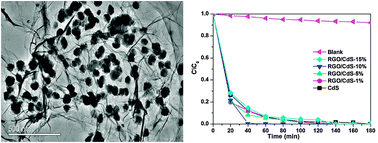Reduced graphene oxide–CdS nanocomposites with enhanced visible-light photoactivity synthesized using ionic-liquid precursors†
Abstract
A series of reduced graphene oxide and CdS nanocomposites (RGO–CdS) with different weight ratios of RGO have been synthesized by a facile microwave-assisted solvothermal method, in which the room temperature ionic-liquid 1-butyl-3-methylimidazolium thiocyanate ([BMIM]·SCN) served as sulfur source as well as stabilizing agent. RGO sheets were uniformly decorated by CdS nanospheres in the as-prepared samples. Only aggregates of CdS particles over 100 nm were obtained, when graphene oxides were not employed. The existence of RGO could effectively enhance the photocatalytic activity for the degradation of rhodamine B (RhB) under visible light irradiation and the RGO–CdS-10% sample possessed the highest activity and excellent stability. The improved photocatalytic efficiency of RGO–CdS nanocomposites could be attributed to the enhanced adsorbability of RhB molecules, a broadened light response range in the visible spectrum and improved separation efficiency of electron–hole pairs, all of which result from the introduction of RGO. It is hoped that this facile and efficient synthesis route can promote the exploration and utilization of graphene-based semiconductor nanocomposites as visible-light photocatalysts.


 Please wait while we load your content...
Please wait while we load your content...